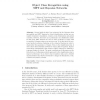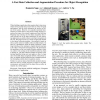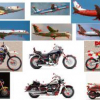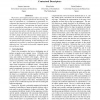MICAI
2010
Springer
14 years 3 months ago
2010
Springer
Several methods have been presented in the literature that successfully used SIFT features for object identification, as they are reasonably invariant to translation, rotation, sc...
DICTA
2008
14 years 6 months ago
2008
This paper explores how to exploit shape information to perform object class recognition. We use a sparse partbased model to describe object categories defined by shape. The spars...
CLOR
2006
14 years 7 months ago
2006
We present a method for object categorization in real-world scenes. Following a common consensus in the field, we do not assume that a figure-ground segmentation is available prior...
AAAI
2008
14 years 7 months ago
2008
When building an application that requires object class recognition, having enough data to learn from is critical for good performance, and can easily determine the success or fai...
ACCV
2007
Springer
14 years 11 months ago
2007
Springer
Abstract. The importance of spatial configuration information for object class recognition is widely recognized. Single isolated local appearance codes are often ambiguous. On the...
ICCV
2005
IEEE
15 years 7 months ago
2005
IEEE
In this paper we compare the performance of local detectors and descriptors in the context of object class recognition. Recently, many detectors / descriptors have been evaluated ...
CVPR
2007
IEEE
15 years 7 months ago
2007
IEEE
We present a hierarchical generative model for object recognition that is constructed by weakly-supervised learning. A key component is a novel, adaptive patch feature whose width...
CVPR
2006
IEEE
15 years 7 months ago
2006
IEEE
In this paper we propose an approach capable of simultaneous recognition and localization of multiple object classes using a generative model. A novel hierarchical representation ...
CVPR
2005
IEEE
15 years 7 months ago
2005
IEEE
We combine local texture features (PCA-SIFT), global features (shape context), and spatial features within a single multi-layer AdaBoost model of object class recognition. The fir...
CVPR
2005
IEEE
15 years 7 months ago
2005
IEEE
We present a novel approach for fast object class recognition incorporating contextual information into boosting. The object is represented as a constellation of generalized corre...




